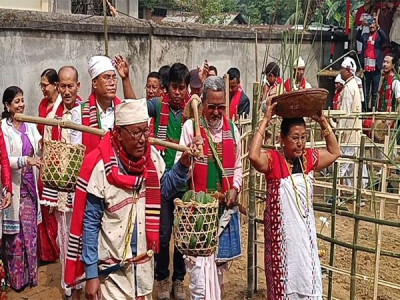Detailed Notes
Among all, the Ali Aye Ligang is the most prominent festival of the Mising people. Celebrated on the first Wednesday of the Assamese month of Phagun (February–March), it marks the beginning of the sowing season. The term ‘Ali’ means root or seed, ‘Aye’ means fruit, and ‘Ligang’ refers to sowing — together symbolizing fertility and new beginnings. The eldest woman of the household leads the ritual by planting the first seed, followed by prayers to deities such as Donyi-Polo (Sun and Moon). The festival features the famous Gumrag dance, traditional songs, and community feasts with rice beer, fish, and meat. Ali Aye Ligang is often compared to Bohag Bihu, as both celebrate agricultural prosperity.
Another significant celebration is the Po’rag festival, held after the harvest season to thank ancestral spirits for protection and good yield. It also aims to safeguard crops from pests and natural calamities. Villagers organize community prayers, feasts, and the traditional Porag dance, symbolizing unity and harmony among neighboring villages.
The Amrok festival, observed in August–September (Bhadon/Ahin), is dedicated to honoring ancestors. Families prepare food from freshly harvested crops and offer it to forefathers, seeking blessings for peace and abundance. The festival concludes with collective dancing and merrymaking, emphasizing social harmony.
The Nora-Chiga festival or Puh-Rug is another important village-level celebration where relatives gather, share meals, and engage in Vaishnavite devotional practices like Raas dance and recitation of Namghosa and Kirtan. It reflects the community’s connection with both traditional animistic beliefs and the Assamese Vaishnavite faith introduced by Srimanta Sankardeva.
Each Mising festival reflects a deep bond with the natural environment, emphasizing coexistence, agriculture, and spirituality. Whether it’s planting seeds in Ali Aye Ligang, honoring ancestors in Amrok, or celebrating community ties during Po’rag and Nora-Chiga — every event represents the living essence of Mising cultural identity in Assam.
FAQs with Short Answers:
-
What is the main festival of the Mising community?
Ali Aye Ligang is the most popular and widely celebrated festival of the Mising community. -
When is Ali Aye Ligang celebrated?
It is celebrated on the first Wednesday of the Assamese month of Phagun (February–March). -
What does Ali Aye Ligang mean?
The term means the festival of sowing seeds, symbolizing fertility and new beginnings. -
What is the Po’rag festival about?
Po’rag is celebrated after harvesting to thank ancestral spirits and pray for protection. -
When is Amrok celebrated?
Amrok is observed in August–September, offering food to ancestors. -
What is Nora-Chiga or Puh-Rug?
It is a village-level Mising festival celebrating family unity and Vaishnavite devotion. -
Which dance is performed during Ali Aye Ligang?
The famous Gumrag dance is performed during this festival. -
What kind of food is prepared during Mising festivals?
Dishes made of rice, fish, meat, and local rice beer are prepared and shared. -
Which deities do the Mising people worship?
They primarily worship Donyi-Polo, representing the Sun and Moon, as nature deities. -
What is the cultural importance of Mising festivals?
These festivals promote community bonding, agricultural prosperity, and ancestral respect.
